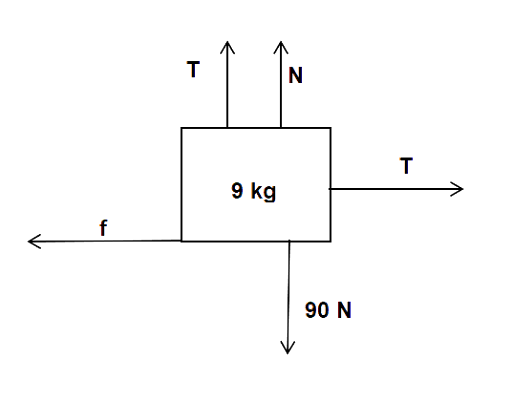
A boy with a mass of 4 kg is standing on a piece of wood with a mass of 5 kg. If the coefficient of friction between the wood and the floor is 0.5, the maximum force that the boy can exert on the rope so that the piece of wood does not move from its place is ________N. (Round off to the Nearest Integer)
[Take \[g = 10{\text{ m/}}{{\text{s}}^2}\]]

Answer
220.8k+ views
Hint: In this question, we need to determine the maximum force that the boy can exert. For this, we need to equate the frictional force (T) and the force exerted by the body. Also, we will use the following formula to get the desired result.
Formula used:
The formula for frictional force is given by
\[F = \mu N\]
Where, \[F\] is the frictional force, \[\mu \] is the coefficient of friction and \[N\] is the normal force.
Complete step by step solution:
We can say that the frictional force is equal to the force exerted by a boy.
\[F = T\]
But we know that\[F = \mu N\]
So, we get
\[\mu N = T\]

According to the given figure, we can say that \[N + T = 90\]
Also, \[\mu = 0.5\]
Thus, \[N = 90 - T\]
By putting these values in equation \[\mu N = T\]
So, we get
\[0.5\left( {90 - T} \right) = T\]
\[\Rightarrow 45 - 0.5T = T\]
\[\Rightarrow T + \dfrac{T}{2} = 45\]
By multiplying 2 on both sides, we get
\[2T + T = 90\]
\[\Rightarrow 3T = 90\]
By simplifying, we get
\[\therefore T = 30\]N
Therefore, the maximum force that the boy can exert on the rope so that the piece of wood does not move from its place is 30 N.
Note: Many students make mistakes in writing the formula for the frictional force. As a result, the end result may get wrong. Here, the simplification part for calculating normal force is also important for getting the final answer.
Formula used:
The formula for frictional force is given by
\[F = \mu N\]
Where, \[F\] is the frictional force, \[\mu \] is the coefficient of friction and \[N\] is the normal force.
Complete step by step solution:
We can say that the frictional force is equal to the force exerted by a boy.
\[F = T\]
But we know that\[F = \mu N\]
So, we get
\[\mu N = T\]

According to the given figure, we can say that \[N + T = 90\]
Also, \[\mu = 0.5\]
Thus, \[N = 90 - T\]
By putting these values in equation \[\mu N = T\]
So, we get
\[0.5\left( {90 - T} \right) = T\]
\[\Rightarrow 45 - 0.5T = T\]
\[\Rightarrow T + \dfrac{T}{2} = 45\]
By multiplying 2 on both sides, we get
\[2T + T = 90\]
\[\Rightarrow 3T = 90\]
By simplifying, we get
\[\therefore T = 30\]N
Therefore, the maximum force that the boy can exert on the rope so that the piece of wood does not move from its place is 30 N.
Note: Many students make mistakes in writing the formula for the frictional force. As a result, the end result may get wrong. Here, the simplification part for calculating normal force is also important for getting the final answer.
Recently Updated Pages
Two discs which are rotating about their respective class 11 physics JEE_Main

A ladder rests against a frictionless vertical wall class 11 physics JEE_Main

Two simple pendulums of lengths 1 m and 16 m respectively class 11 physics JEE_Main

The slopes of isothermal and adiabatic curves are related class 11 physics JEE_Main

A trolly falling freely on an inclined plane as shown class 11 physics JEE_Main

The masses M1 and M2M2 M1 are released from rest Using class 11 physics JEE_Main

Trending doubts
JEE Main 2026: Application Form Open, Exam Dates, Syllabus, Eligibility & Question Papers

Understanding Uniform Acceleration in Physics

Derivation of Equation of Trajectory Explained for Students

Hybridisation in Chemistry – Concept, Types & Applications

Understanding the Angle of Deviation in a Prism

How to Convert a Galvanometer into an Ammeter or Voltmeter

Other Pages
Thermodynamics Class 11 Physics Chapter 11 CBSE Notes - 2025-26

JEE Advanced Marks vs Ranks 2025: Understanding Category-wise Qualifying Marks and Previous Year Cut-offs

Units And Measurements Class 11 Physics Chapter 1 CBSE Notes - 2025-26

NCERT Solutions For Class 11 Physics Chapter 8 Mechanical Properties Of Solids

Motion in a Straight Line Class 11 Physics Chapter 2 CBSE Notes - 2025-26

Laws of Motion Class 11 Physics Chapter 4 CBSE Notes - 2025-26




